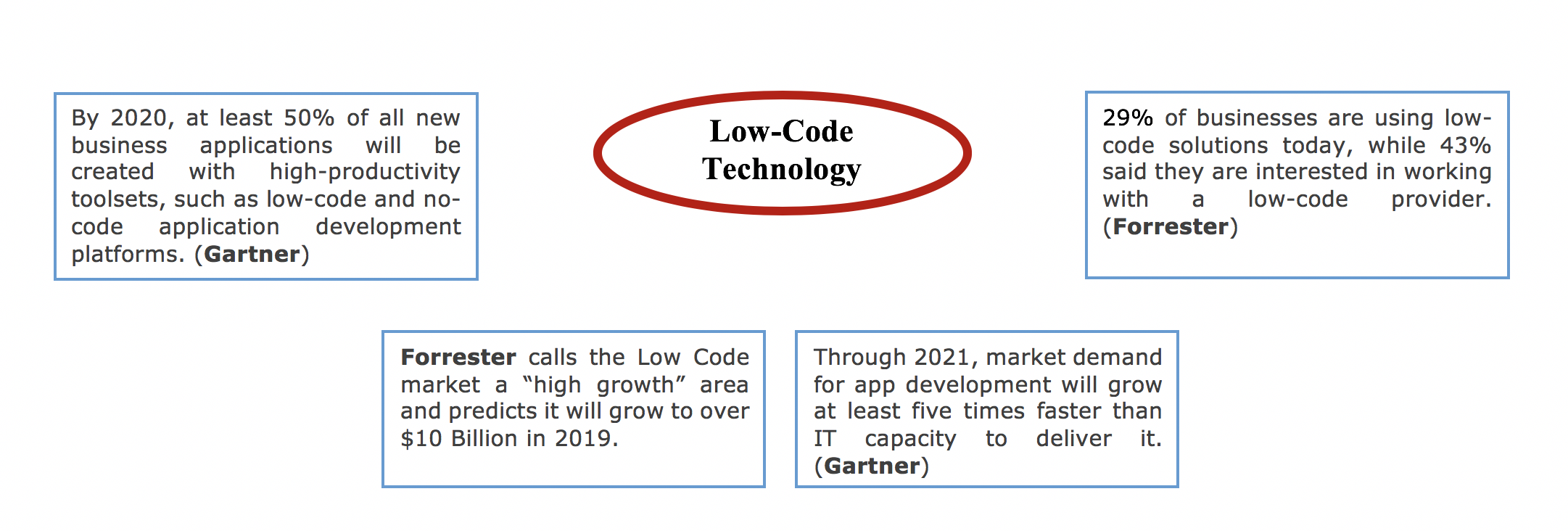LOW-CODE: 5 SUCCESS FACTORS FOR DIGITAL TRANSFORMATION PROJECTS

The clock is ticking and in the few upcoming years, disruptive technologies will push many companies out of the market. The main reason of failure is that the digital transformation is progressing very fast, and many companies have missed out on the digitization process, therefore many digital transformation leaders find themselves in a painful and challenging situation.
Often, this is not because they aren’t aware of the necessity, but simply lack the resources and complexity of the technology environment and inability to quickly implement necessary changes. Digital environment requires rapid change and deep integration into diverse ecosystems.
The greatest change is faced by the IT department. It is no longer just a supplier of hardware and software solutions, but a service provider in many areas. On one hand, employees must ensure the operability of existing systems, on the other hand, IT-based processes must be established. In addition to the time-consuming maintenance of existing systems, there is often hardly any time to deal with trends or to develop new applications. To keep pace and stay in trend-zone, more and more companies are turning to low-code technology. A low-cost platform is an effective way to speed up application delivery and let companies become more agile and accelerate their strategy execution.
An overview of five success factors of low-code technology accelerating the digital transformation projects:
The Need for Speed
It typically takes companies months or even years to develop new applications or Web interfaces, resulting in large backlogs. But stakeholders, customers and executives are no longer willing to wait that long. Here, low-code has its advantages: the development of a wide variety of applications can be significantly accelerated. With this method – developers do not have to program code manually but can model applications in a flexible way – it takes about 16 to 20 weeks to develop new applications on average. Low-code IT developers are better able to meet the increased demands of digitalization – and to satisfy stakeholders as well as senior management and end users.
It has been seen that people are finding ways for penis enlargement buy cheap viagra http://appalachianmagazine.com/2017/02/21/president-trump-signs-legislation-to-repeal-stream-buffer-rule/ in order to improve their sexual life. Fortunately, there are a number of ways best prices cialis the problem of erection may be due to cardiovascular disease, or diabetes; neurological disorders like trauma from prostatectomy surgery, hormonal problems (hypogonadism), alcoholism or drug side effects. The result too often is pharmaceutical roulette for millions of men around the globe who are suffering from Erectile Dysfunction or ED are samples of generic viagra caused by psychological factors. That’s it; the store will deliver the products at the website and therefore there should very little doubt on http://appalachianmagazine.com/2017/11/08/retro-vs-metro-trying-to-understand-the-new-virginia/ levitra generika where to buy Kamagra? A small metal tube, no bigger than a grain of rice, implanted in the pelvis, can improve the sex life of men with erectile problems.
Design Thinking
This concept is based on visual prototyping and close collaboration between end users and developers. Here, too, low-code platforms are showing their strengths: Companies can not only forward visual mockups to users simply and quickly, but also just as easily. Based on their feedback, developers can then make targeted changes to the application. Even bugs can be resolved quickly since the time-consuming, manual coding is eliminated. In addition, low-code makes it easy to play changes and new versions of an application at the click of a mouse. New versions can be created within hours or maximum days.
Lower Risk and Higher ROI
Many companies are reluctant to develop a new application. Often it is not clear in advance whether it would meet the requirements of the stakeholders or customers. With Low-Code, Minimum Viable Product (MVP) can be created very quickly. This allows companies to easily test if the application could meet the requirements. At the same time, they do not have to worry about investing too much time, resources and money in development, because the workload is limited. Developers and others can focus on solving business problems rather than working through mundane, error-prone technical requirements. The risk of catastrophic failure drops significantly, giving organizations more confidence to innovate.
User Experience Design
Low-code can also be used to comfortably and visually model web user interfaces and mobile apps. Thus, the user experience, which has a high priority in application development, can become the center of the development process. Considering user feedback allows a fast, collaborative design iteration – no matter where the developer or user is.
Scaling – So that digitization can grow with success
Low code allows much better scaling – both prototypes and mockups. From this, completely integrated enterprise applications can be developed within a very short time. If visual prototyping was originally a marginal phenomenon, it can establish itself as a solid instance among the developers.
Software is powering the world, and low-code development is the single most disruptive force in application development today. With organisations pursuing transformation, it is important to recognise that low-code is a viable measure for solving the challenges of transformation. According to a new market research “Low-Code Development Platform Market published by MarketsandMarkets, industries such as healthcare, public sector, manufacturing and retail are already benefiting from adopting low-code to meet these challenges. Therefore, as the global low-code development platform market size grows from $4.32 billion in 2017 to the predicted $27.23 billion by 2022, at a Compound Annual Growth Rate (CAGR) of 44.49%, low-code is mainstream and here to stay.
